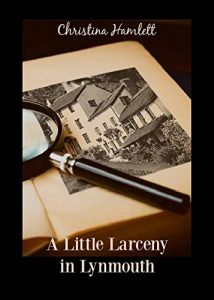What Makes Authors Real?
WHAT MAKES AUTHORS REAL?
By Christina Hamlett
 Once upon a long ago time, a velveteen rabbit felt insecure and inadequate when he looked around at the fancier, mechanical toys in the playroom. How could he live a happy life when the bar to perfection was set too high and beyond his reach? Even real rabbits in the summer woods snubbed him because he couldn’t hop around. Dratimus maximus! What does a bunny have to learn in order to finally feel authentic?
Once upon a long ago time, a velveteen rabbit felt insecure and inadequate when he looked around at the fancier, mechanical toys in the playroom. How could he live a happy life when the bar to perfection was set too high and beyond his reach? Even real rabbits in the summer woods snubbed him because he couldn’t hop around. Dratimus maximus! What does a bunny have to learn in order to finally feel authentic?
This year marks the first century anniversary of Margery Williams’ sweet tale, and what better time to remind aspiring authors that if they allow “real” to be defined for them by their family, friends and co-workers, they’re missing the point about the creative process. How many writers do you know, for instance, who have penned blogs, articles and short stories but are reminded they have yet to achieve “real author” status because they haven’t written a book? Further, how many have gone the self-publishing route with their work but had naysayers tell them it’s too bad a traditional house didn’t validate their worth?
While a contract with The Big Five may be an author’s dream, the traditional publishing industry has shrunk rather than expanded in recent years—the combined product of a wobbly economy and the zeitgeist of being politically relevant. Investing in a new voice—even if that voice is particularly gifted—is still a risk which acquisitions editors are reluctant to take. In a nutshell, it’s job security to say “no” to a newcomer’s submission rather than say “yes” and have to deal with the consequences of its potential failure. This, in turn, has given rise to more and more authors embracing self-publishing (not to be confused with vanity presses) and having more control over their own intellectual property.
It’s important to dispel the myth that once you sign with a traditional house, it will do all of the work for you. Yes, maybe if you’re Stephen King or J.K. Rowling. The reality is that before a contract is even offered, you’ll need to prove you have a marketable product and are a demonstrable presence on social media. Today’s expectation is for authors to do the lion’s share of the legwork to promote a new release.
Yet for all of this marketing and hype you’ll be expected to generate yourself, it’s for a royalty of only 8-12%. Furthermore, you’re looking at 18-24 months before your book gets into bookstores. Once there, it will enjoy a shelf-life of approximately two weeks unless it’s a runaway hit. As if these statistics weren’t sobering enough, consider that you’ll likely have no say-so in whether your book’s title gets changed and even less say-so in your cover design. While smaller houses are generally more accommodating in working one-on-one with their authors, the advances and royalties will be much smaller…plus you still have to do all that marketing.
So what’s the attraction to self-publishing? If you’re a savvy editor/proofreader, excel at formatting/layout and have professional cover design skills, it’s not going to cost you anything to get your work published and available to readers within 72 hours. While Amazon Kindle currently dominates the market, my own go-to preference is Draft2Digital. Not only do their resources, templates and tech support take all the guesswork out of uploading a manuscript but authors can also define their own pricing, enjoy worldwide distribution channels (including major retailers and storefronts), track their sales, and opt for ebooks, paperbacks and audiobooks. Yes, you’ll be doing all your own marketing and promotion but does a royalty of up to 70% make it sound worth it?
In fairness, Amazon and Draft2Digital aren’t the only games in town. Reedsy has not only assembled their own list of self-publishers (https://blog.reedsy.com/best-self-publishing-companies) but they have a simple online quiz, too, which can help you identify who might be the best fit for your needs and budget. Take your time researching your options!
If you still want to hold out for a “real” publisher, bear in mind that most medium to large companies require pitches be made via literary agents. The Catch-22 in this, however, is many agents only want to look at prospective clients who already have a significant body of published works. Agents are also as risk-averse as editors and—if they do agree to represent you—will expect 10-15% of your advance.
Whereas a pleasant, snail-mailed letter of introduction worked well in the past, almost everything nowadays is done electronically and consists of a detailed form regarding your project and how it compares to other books on the market. Of late, some agents also ask authors to reveal their age, gender and sexual orientation (none of which has anything to do with whether they can put a sentence together). In addition, many request “exclusivity” for a reading period of 4-6 months.
All of this said, I respect authors for whom “real” is a genuine benchmark of success. At the same time, I wonder how many wonderful books will never see the light of day because their authors believed a self-published title somehow took less time, energy and passion to write than one vetted by The Big Five.
“Real isn’t how you’re made,” the wise old horse told the velveteen rabbit. “It’s a thing that happens to you.” And when readers tell you that they loved, loved, loved your story, how much more real do you need to be?
*****
Former actress and theatre director Christina Hamlett is an award-winning author of 45 books, 265 stage plays, and squillions of articles and interviews. Her latest release, A Little Larceny in Lynmouth, is the first book in her new cozy mystery series set in the UK.
Christina Hamlett
The picturesque harbor village of Lynmouth on the Devon coast was supposed to be a respite after being made redundant from her job at a prestigious import/export firm in London. But when her landlady is poisoned by chocolate a scant three days after she moves in, Rochelle Reid and her new neighbors discover they have become overnight murder suspects.
Red herrings abound, romance teases, a heroine learns her past is about to collide with the present, and a daylight break-in at the house hints that—even with a victim neatly out of the way—the murderer is not yet in the clear if a damning piece of evidence hidden within its walls isn’t recovered.
BUY HERE
Category: How To and Tips
































I used The Velveteen Rabbit analogy when my first book was accepted by a publisher. The experience was a disaster (for many reasons) and with the assistance of my attorney, we pulled the book from them using breach of contract. With the help of friends, I self-published through Amazon and continue to do so, although I also list paperback through Ingram Sparks so bookstores and libraries can order. I manage to get myself on top-ten lists, have a loyal following, and have lots of book-clubs scheduled on zoom and in person. What could be bad about that?
I contract with professional editors and designers, do all the pr work myself, use judicious advertising, and have done okay. Would I like more sales? Sure. But right now, it’s the best of all worlds.
And I still feel like The Velveteen Rabbit every time I drop a new book.
Thanks for sharing this. And best of luck on future book sales!
I love this, Christina! I wish I could attach a photo here because I’d show you the stuffed velveteen rabbit and the accompanying book I bought myself to celebrate my debut memoir being published next year. Small press – not a big 5 or self-publishing. But it was 20 years in the making, and now, it’s a real thing. WHEN readers love it, the “real” will be, well, unreal!